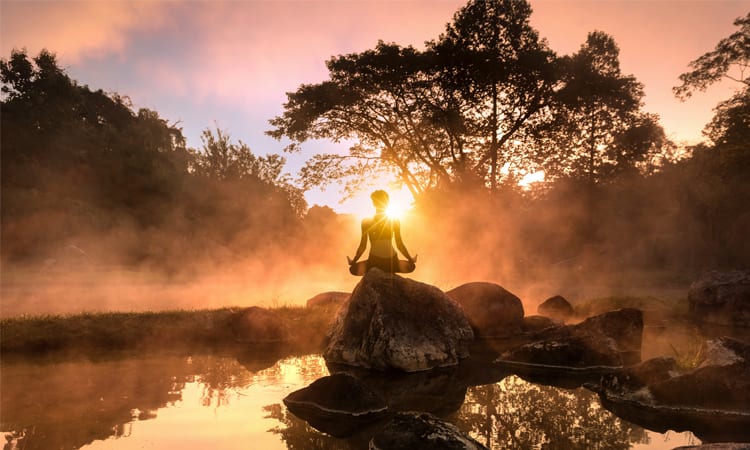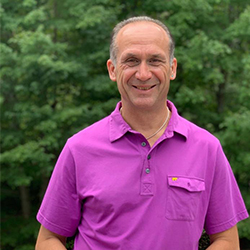
An Interview with Raama Das
Often misunderstood, Tantra is a branch of Yoga that encompasses many schools and lineages and includes various practices and philosophical threads, much like classical Yoga. Knowledgeable Integral Yoga teacher Raama Das not only has experience in the Tantric path, but is also sharing Tantric practices at Yogaville this fall. In the following interview, Raama Das talked about his Tantric background and shared some helpful information on Tantra and Tantric practices.
Yogaville: In your upcoming workshop, Loosening the Knots, you’ll be guiding students in Yoga practices from the Tantric tradition. While Tantra is a widely-recognized word, few understand its meaning. Could you explain Tantra Yoga? How is it different than other yogic traditions?
Raama Das: (Laughs) Well, I’ll try! My understanding of Tantra comes mostly from practical experiences and is not so much based on an intellectual understanding. As a student of Tantra, I didn’t study Patanjali’s Yoga Sutras, for example, as we do in Integral Yoga. Instead, through a direct teacher-student relationship I was guided and directed to find my own experience in a range of practices rather than focusing too much on theory and philosophy. Tantra is a tradition that recognizes how people really are. It is not heavily based on ethical perfection and offers a more realistic—rather than idealistic—starting point. It recognizes that we’re not all looking to become renunciates in this lifetime, and it is well-suited for those living regular lives. Through a regular practice of Tantra you can learn about your own mind and body, thereby finding your way to spiritual development and connection to self.
My training has been very much tied up with classical Hatha Yoga — the body being the main instrument in physical postures and kriyas. I have participated in sustained sadhana (practice) that has taken me to a deep experience relatively quickly. In that sense, it’s a bit like Kundalini Yoga. You are working with energy directly as a way to expand your consciousness. There were almost no lectures, just sadhana. It was very experiential and included the foundational practices that I will be sharing during the “Loosening the Knots” workshop, Hatha Yoga, pranayama, Yoga Nidra, and Karma Yoga, but very little discussion. Tantric texts of course exist, but my teachers did not spend our limited time on retreat attempting to intellectualize Yoga—that understanding would happen naturally through direct personal experience of the practices.
Yogaville: Where and how did you learn Tantra Yoga?
Raama Das: I studied in Sweden at the Scandinavian Yoga and Meditation School with Swami Janakananda, who is in his late 70s now. He was inspired by practicing Yoga in a limited way when he was younger. It helped him overcome anxiety and respiratory problems. As a young man, he practiced physical Yoga as part of his acting career in the 50s. He then traveled to India to study Tantra Yoga.
Yogaville: How did you discover Swami Janakananda and the Tantric Yoga tradition?
Raama Das: At least 15 years ago, maybe longer, I started to research more about traditional Yoga. I’d been attending Yoga classes in England since I was 30, but I knew there was more to Yoga than what I was getting. I found the Scandinavian Yoga and Meditation School online and requested more information. They mailed me a program guide and I had it for a long, long time—maybe 5 years or more. I was fascinated by the ideas in the program guide that they sent out. I had been living in Portugal, and my time there was coming to an end. I made a vision board as part of a career guidance activity, and on the board I put a picture of me as a baby on the front cover of the Scandinavian Yoga and Meditation School program guide, which was a visual representation of the koshas—though I knew nothing about what that meant at the time. A few weeks later, I had the opportunity to go. It was a life-changing experience. In two weeks, I went from feeling anxious about where I was in life to feeling very calm. That experience inspired me to become a Yoga teacher, but I didn’t have the time to spend six years studying with Swami Janakananda, and that’s how I found Yogaville and Integral Yoga.

Tantric practices include pranayama, or yogic breathing exercises.
Yogaville: What are some of the Tantric practices that you’ll be offering during your workshop?
Raama Das: In the program I’ll be leading at Yogaville, Loosening the Knots, I’ll offer various short programs, maybe 20 minutes each or longer, done as preparation for classical Hatha Yoga. Many beginners to Yoga may not be physically, mentally, or spiritually ready to go straight into a classical Yoga sequence and first need to learn how to prepare the body and mind. When I first came to the Scandinavian Yoga and Meditation School, I started with these same programs.
One program that I’ll be leading is very similar to the joint-freeing series. I’ll guide a sun salutation sequence as a practice in its own right. I’ll also introduce sequences to improve flexibility in the legs and hips so that practitioners can sit comfortably for pranayama and meditation. Another program will be about healthy digestion and releasing toxins from the system. The sequence also helps release deep seated tension. We will explore a sequence that will help strengthen the back and improve the balance. It has quite the vitalizing effect and wakes up subtle energies.
After working with the body directly, we’ll be doing subtle practices to loosen any mental tightness. Participants will have the opportunity to practice mudras to target one’s energy fields. The breathing programs are ideal for those new to Yoga, although anyone can benefit from them, including teachers. One breath practice involves focusing on the breath to become aware of any restrictions, and then incorporating physical practices to relieve that area. Pranayama practices will include deep breathing, kapalabhati, nadi suddhi, and brahmari as a harmonizing and healing breath.
A subtle Tantric practice is Nada Yoga, the Yoga of sound. We’ll explore sound as a healing modality by chanting OM, humming, listening to the internal sound, and bringing all of these components together. Yoga Nidra is a big practice in Tantra as well. I will introduce the Bihar School of Yoga approach which offers a directed body scan and guided visualization using totems or symbols as a way of reaching deeper into the subconscious. The practice is very relaxing and stress relieving, and also works on a deep level to bring us to the understanding that we are not the body, not the mind. Participants will also have the opportunity to incorporate sankalpa (intention) in their Yoga Nidra practice.
In the workshop we will also explore meditation practices that are accessible to beginners. Specifically, we’ll engage in a mindfulness practice about experiencing the present moment to bring about peace. In another subtle practice, students will be directed to experience the movement of the breath as they inhale and exhale through the chakras and then incorporate mantras. It has a healing effect and it is a great practice for an easily-distracted mind.
Yogaville: As a Yoga therapist, could you speak about the benefits of these practices?
Raama Das: These practices have similar benefits to traditional, classical Yoga practice. But rather than the specific benefits you might receive from practicing cobra pose or shoulderstand, these Tantric practices provide a more general tune-up for the system. Loosening Up the Knots will offer an overall balancing practice for the body, mind, and spirit. These are relatively simple practices, and they can be especially beneficial for beginners. With instruction and practice, participants should be able to take them home with them!
These practices are foundational. As a teacher, I use them with new students when I think they might struggle with classical practice and classical adaptations. I also use these practices in my own practice before a classical sequence or when I’m traveling and need to loosen up a bit myself.

